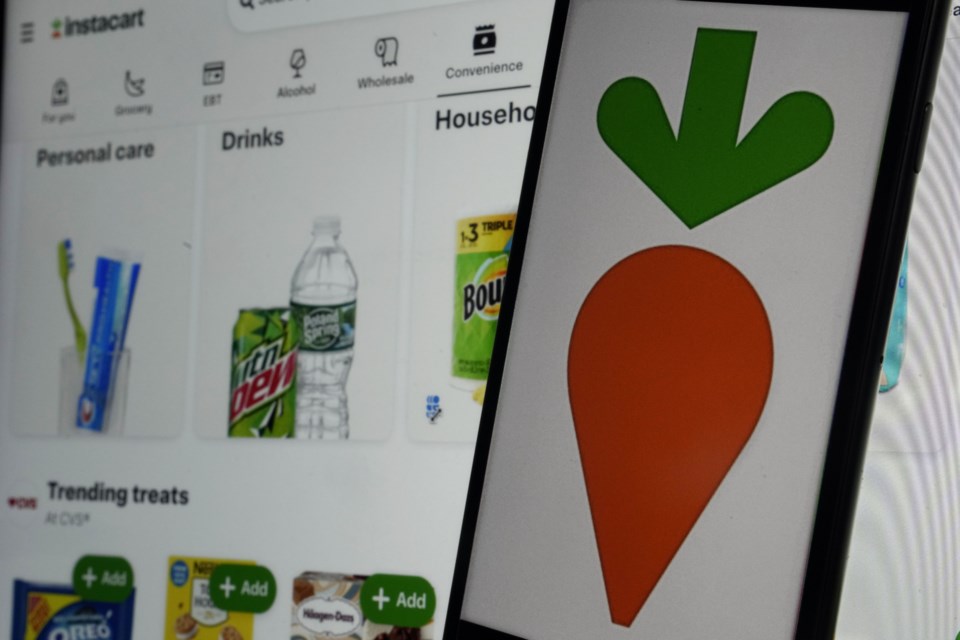Instacart delivered in its stock market debut.
The grocery delivery company's shares __ priced at $30 per share ahead of the IPO __ hit a peak of $42.95 Tuesday in the first few minutes of trading on the Nasdaq stock exchange. They finished the day up 12.3% at $33.70, giving the company a market value of more than $11 billion.
At Instacart's San Francisco headquarters, CEO Fidji Simo and other executives celebrated the IPO by ringing a bell shaped like the company's carrot logo. Around 1,000 employees attended, the company said. Instacart’s shares are trading under the ticker symbol “CART.”
The IPO is a long-awaited step for Instacart, which was founded in 2012. The company filed privately for an IPO in May 2022 but delayed those plans last fall when the markets were roiling due to recession fears. There were just 71 IPOs in the U.S. last year, the lowest number since 2009, according to Renaissance Capital.
But a resurgent market is seeing more IPO activity this year. Last week, shares of U.K. chip maker Arm Holdings rose almost 25% in their stock market debut on the Nasdaq, the largest IPO in nearly two years.
Joe Endoso, President at Linqto, an investment platform, said a successful listing by Instacart could prod others __ especially tech companies __ to consider IPOs in the coming months.
“The global financial markets are buzzing with optimism for a potential resurgence in the IPO market,” he said.
Instacart raised $660 million in its initial public offering, selling 22 million shares at $30 apiece. The pricing of the IPO gave Instacart a market value of around $10 billion, significantly lower than the $39 billion value placed on it after a fund-raising round in 2021.
Instacart provides delivery and pickup from 85% of U.S. grocers, or more than 80,000 stores, using a network of 600,000 freelance shoppers. It also provides in-store technology, like smart carts and electronic shelf tags, and sells online ads to food companies and retailers.
It says it has 7.7 million active customers who spend about $317 per month on the platform.
In a letter to investors earlier this month, said grocery delivery has tremendous potential. The U.S. grocery market is a $1.1. trillion industry, but only 12% of sales are made online. She said she expects that to at least double over time.
“We have demonstrated our ability to help our retail partners drive strong growth and stay competitive in a complex and increasingly digital industry,” wrote Simo, a former Facebook executive who became Instacart’s CEO in 2021. Simo grew up in France and is the daughter and granddaughter of fishermen.
The grocery delivery market boomed early in the pandemic. Growth has stabilized, but the market is still about four times larger than it was in 2019, said David Bishop, a partner and lead researcher with Brick Meets Click, a consulting firm that specializes in online grocery shopping.
That market is also increasingly competitive. Instacart faces growing pressure from companies including Uber Eats and DoorDash, which both began delivering groceries in 2020.
As of August, Instacart controlled 70% of the third-party U.S. grocery delivery market, according to YipitData, a market research firm. DoorDash controls around 10%. This week, DoorDash added more U.S. grocers to its offerings, including Cub, Lowe’s Markets and Eataly.
Instacart also faces pressure from grocers themselves, who sometimes bristle at the higher prices Instacart charges or at the pricing rules it puts in place for grocers using its software to run their own websites.
Instacart orders can cost consumers 15% to 20% more than shopping in stores because of delivery fees and product markups, Bishop said.
Some grocers have unwound partnerships with Instacart or built up their own delivery capability. H-E-B, a Texas chain, encourages customers to shop on its own site, not Instacart’s, if they want lower-cost delivery, Bishop said. Other big grocers, like Walmart and Target, also do their own deliveries.
Bishop said Instacart needs to keep its customers coming back because it relies on them to sell ads.
“It's increasingly difficult to see how Instacart can do that as its competitors are expanding into grocery and grocers are looking more closely at how they can improve the profitability of selling online," he said.
Food price inflation over the last two years has also dampened demand for delivery in favor of curbside pickup, which is less expensive. U.S. grocery pickup orders grew 3% to $10.5 billion in the April-June period this year compared to the same period a year ago, Bishop said. Grocery delivery orders grew just 1% to $7.8 billion.
Instacart’s orders also slowed in the first half of this year after growing 18% between 2021 and 2022, the company said in its IPO filing.
Still, Instacart’s revenue was up 31% to $1.47 million in the first six months of this year, largely due to increases in the advertising fees it collects from retailers and food companies. The company reported net income of $242 million in the first six months of this year.
Among those bullish about Instacart's prospects is PepsiCo, which agreed to buy $175 million in convertible preferred stock in a private placement.
Dee-ann Durbin, The Associated Press




